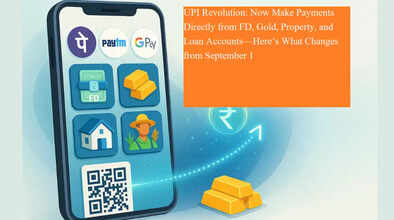UPI Revolution: Now Make Payments Directly from FD, Gold, Property, and Loan Accounts—Here’s What Changes from September 1

In a major move to expand the digital payments ecosystem in India, the National Payments Corporation of India (NPCI) has announced a transformative update to the Unified Payments Interface (UPI) system. From September 1, 2025, users will be able to link fixed deposits (FDs), gold holdings, property-linked accounts, and even personal and business loan accounts to UPI for making direct payments through apps like Google Pay, PhonePe, Paytm, and others.
This groundbreaking update is aimed at making digital transactions more inclusive and dynamic—especially for small business owners, traders, and loan account holders. Here's what you need to know about the new UPI norms.
What’s New in the UPI Rules?
Until now, UPI transactions were mostly limited to savings accounts, current accounts, and in select cases, RuPay credit cards. However, with the latest guidelines issued by NPCI on July 10, 2025, users can now link and transact from FD accounts, loan accounts, and even asset-backed accounts like gold and property.
This means that if you have a business loan from a bank, you’ll be able to use that loan account directly for UPI payments by simply scanning a QR code—just like how UPI currently works with savings accounts.
How Will It Work?
For instance, let’s say you’ve taken a loan to expand your shop and you need to pay ₹2 lakh to a supplier. Earlier, this required a manual bank transfer. But starting in September, you’ll be able to pay directly through UPI using your business loan account—fast, simple, and secure.
Transaction Limits Set by NPCI
While the system opens many new doors, NPCI has also set clear limits to ensure safe and responsible use:
-
Maximum Daily UPI Payment: ₹1,00,000
-
Cash Withdrawal Limit via UPI: ₹10,000 per day
-
Daily P2P Transaction Cap: 20 transactions
These limits apply across the board and are designed to prevent misuse, especially from credit-linked accounts.
Who Can Use This New Feature?
Not everyone will have unrestricted access to all features. Whether or not you can link and transact from a loan or asset-based account depends largely on your bank’s internal policy. For example:
-
If you have a loan against gold, your bank may only allow UPI payments for essential needs—like medical bills or education fees.
-
You won’t be allowed to use the same loan account to purchase additional gold, ensuring responsible use of borrowed funds.
This selective usage model is designed to protect both customers and lenders from credit misuse while enabling digital empowerment.
Benefits for Small Businesses and Farmers
This change will be particularly beneficial for small-scale merchants, retailers, and farmers, who often take short-term loans. They can now scan a QR code and make UPI payments directly from their business loan account, eliminating delays and offering greater flexibility in managing funds.
NPCI’s Vision Behind the Update
NPCI’s goal with this move is to elevate UPI into a comprehensive financial ecosystem. By enabling loan accounts and credit lines to operate seamlessly within UPI apps, NPCI aims to make digital wallets more powerful and inclusive.
It also emphasizes financial accountability. Each transaction will require bank-level authentication, and all payment limits will be strictly enforced.
Final Thoughts
With this major UPI upgrade, India’s digital payments landscape is on the brink of a new era. From FDs to business loans, your entire financial portfolio may soon be accessible through your smartphone. As this new feature rolls out from September 1, both individuals and businesses should connect with their banks to understand the available services, usage restrictions, and compliance norms.
This isn’t just an update—it’s a leap toward a more flexible, credit-enabled, and digitally-driven India.

